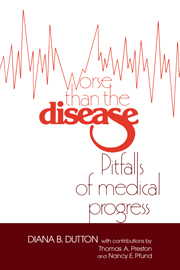Book contents
- Frontmatter
- Contents
- List of contributors
- Preface
- Acknowledgements
- List of abbreviations
- Part I Overview
- Part II Four case studies
- 3 DES and the elusive goal of drug safety
- 4 The artificial heart
- 5 The swine flu immunization program
- 6 Genetic engineering: science and social responsibility
- Part III Lessons, questions, and challenges
- Notes
- Index
3 - DES and the elusive goal of drug safety
Published online by Cambridge University Press: 05 May 2010
- Frontmatter
- Contents
- List of contributors
- Preface
- Acknowledgements
- List of abbreviations
- Part I Overview
- Part II Four case studies
- 3 DES and the elusive goal of drug safety
- 4 The artificial heart
- 5 The swine flu immunization program
- 6 Genetic engineering: science and social responsibility
- Part III Lessons, questions, and challenges
- Notes
- Index
Summary
Really? Yes … desPLEX [a brand of DES] to prevent abortion, miscarriage and premature labor. Recommended for routine prophylaxis in ALL pregnancies … bigger and stronger babies too.
– Grant Chemical Company advertisement, American Journal of Obstetrics and Gynecology, June 1957In February 1938, a brief letter appeared in the British scientific journal Nature announcing the synthesis of a nonsteroidal compound with the properties of natural estrogen. The report was by a British scientist–physician, Sir Edward Charles Dodds of the Courtald Institute of Biochemistry in London, and colleagues at Oxford. The researchers named their new compound “stilboestrol”; it later came to be called diethylstilbestrol, or simply DES.
The announcement ran scarcely over a page, yet it sent ripples of excitement throughout the medical community. Here was a substance that could be used instead of the scarce and expensive natural estrogens in treating a wide range of problems thought to be related to imbalances in sex hormones. Clinical investigators around the world lost no time in launching experiments on patients, and most raved about the results. One researcher, speaking at a national medical meeting in the United States in 1939, called DES “the most valuable addition to our therapy in recent years.” A noted gynecologist declared that it had “tremendous clinical possibilities.” By 1940, the response to DES and other synthetic estrogens had been so favorable that Dodds observed that “their immediate practical value is now established.” But he also had grander visions. “It is perhaps not too much to hope,” he mused in 1940, “that just as aspirin marked the beginning of a new era in medicine, so these compounds may be the first steps along a road leading to great advances in the treatment of disease.”;
- Type
- Chapter
- Information
- Worse than the DiseasePitfalls of Medical Progress, pp. 31 - 90Publisher: Cambridge University PressPrint publication year: 1988
- 2
- Cited by

